MATH 241 -- Multivariable Calculus
Differentiability for ![]() October 20, 2010
October 20, 2010
We have now introduced directional derivatives of ![]() in all
in all
directions ![]() at points
at points ![]() and seen the special cases
and seen the special cases
![]() and
and ![]() that give the partial derivatives:
that give the partial derivatives:
![]() We will next consider the following question: Is there some
We will next consider the following question: Is there some
single object that we can consider as ``the (total) derivative of f "
at ![]() We will see that the answer is yes, but the exact form
We will see that the answer is yes, but the exact form
and the way this appears as a derivative is going to take some explanation.
This is perhaps the area where the ideas from 1-variable calculus need
to be augmented the most to deal with functions of several variables.
To prepare for this, let's go back and reconsider what it means for a
function of one variable, ![]() to be differentiable from a viewpoint
to be differentiable from a viewpoint
that might be new to you. The way you have probably seen this idea
defined in your previous calculus courses is this: ![]() is said to be
is said to be
differentiable at ![]() if the limit
if the limit
![]()
exists and if it does, then this limit computes the value of the derivative
![]() The equation
The equation
![]()
can be rearranged to
![]()
If we rewrite ![]() then
then ![]() and
and ![]()
Therefore this last equation can be rewritten as
![]()
What does this really mean? Well, note that the top is ![]()
where ![]() is the linear function whose
is the linear function whose
graph is the tangent line to ![]() at
at ![]() Not only is
Not only is
![]() as
as ![]() In fact, it is going to zero faster than
In fact, it is going to zero faster than
![]() in the sense that the quotient is still going to zero after we divide
in the sense that the quotient is still going to zero after we divide
by ![]() Intuitively, we can factor
Intuitively, we can factor ![]() out of the top and
out of the top and
cancel with the bottom and what is left is still going to zero as ![]() In graphical terms, this means that when
In graphical terms, this means that when ![]() exists, the graph
exists, the graph
gets very close to the tangent line if we ``zoom in'' on the point ![]()
in a suitable way. Here is an example to show what this means.
We know ![]() is differentiable at
is differentiable at ![]() and
and ![]()
Hence ![]() Here is the graph
Here is the graph ![]()
together with the tangent line plotted over smaller and smaller intervals.
Note how the graph quickly becomes indistinguishable from the tangent
line (up to the resolution of the screen):
| > |
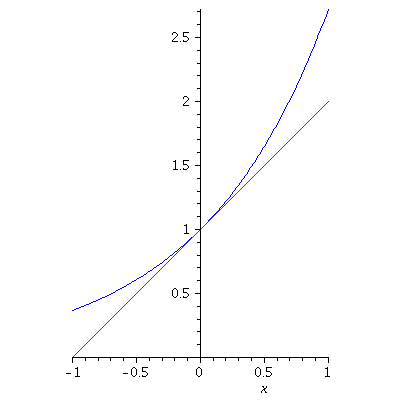 |
| > |
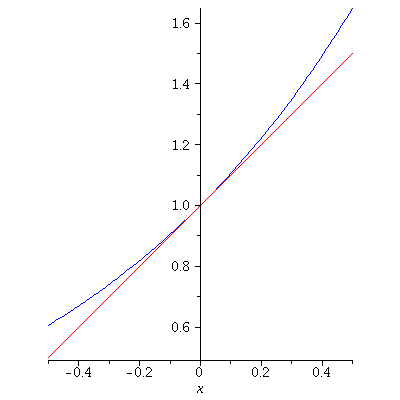 |
| > |
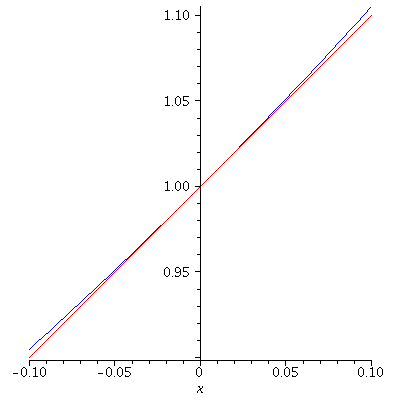 |
| > |
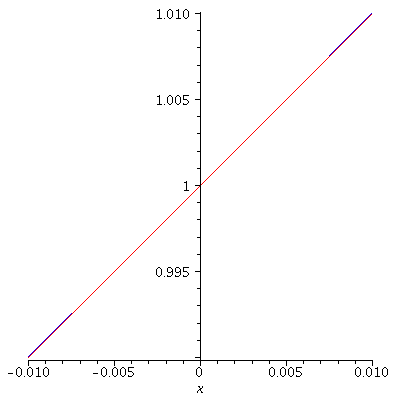 |
Here is the plot of ![]() which indicates how the limit (*) above works in this case.
which indicates how the limit (*) above works in this case.
| > |
 |
This certainly seems to approach 0 as ![]() (This can also be shown, of course, via techniques including
(This can also be shown, of course, via techniques including
L'Hopital's Rule for limits.)
On the other hand, here is a function ![]() and an
and an ![]() where
where ![]() does not exist.
does not exist.
| > |
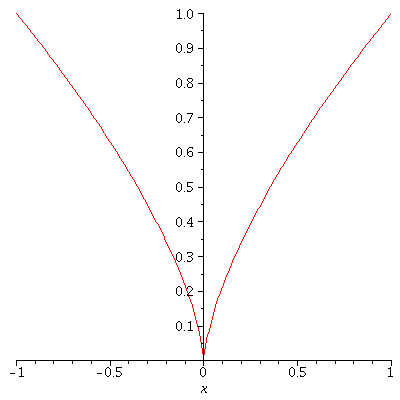 |
Note what happens if we plot ![]() for any real
for any real ![]()
| > |
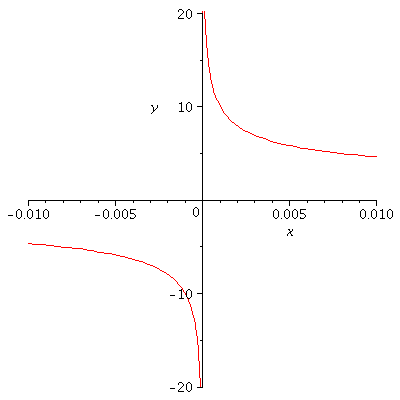 |
We can see
![]() while
while ![]() no matter what the value of a is.
no matter what the value of a is.
Intuitively, no straight line passing through (0,0) approximates the shape of the graph ![]() at all well near (0,0).
at all well near (0,0).
It is this idea of differentiability that extends well to functions of several variables:
Intuitively, we say ![]() is differentiable at
is differentiable at ![]() if there is some linear function
if there is some linear function
![]() graph z =
graph z = ![]() approximates the graph
approximates the graph
z = ![]() well near
well near ![]() More precisely, we say
More precisely, we say ![]() is differentiable at
is differentiable at ![]() if there is some linear function
if there is some linear function
![]() In fact there is only one "candidate" for the linear function: It is possible to see that
In fact there is only one "candidate" for the linear function: It is possible to see that
in ![]()
![]()
![]()
![]()
![]()
![]()
![]()
![]()
![]()
![]()
![]() is a plane in
is a plane in ![]() So the question
So the question
we're asking is really -- does that plane approximate the shape of the graph
![]() well near
well near ![]()
Example 1. Let ![]() We claim that
We claim that ![]() is differentiable at
is differentiable at
![]() We have
We have ![]() and
and ![]() First, we plot
First, we plot ![]() and
and ![]() together to see whether it looks like the plane is approximating the graph well.
together to see whether it looks like the plane is approximating the graph well.
We plot the graphs of f, ℓ together on a small rectangle with (1,2) at the
center:
| > |
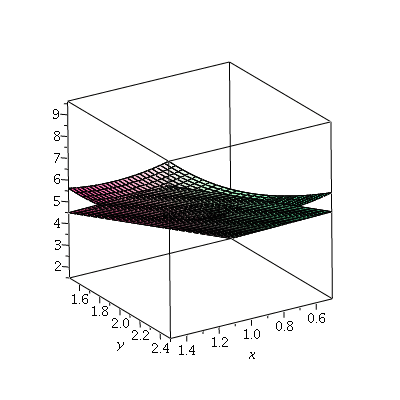 |
This looks pretty good, and it would look progressively better as we zoomed in towards
![]() The next plot shows what happens if we graph the function
The next plot shows what happens if we graph the function
![]()
again on a small rectangle with (1,2) at the center:
| > |
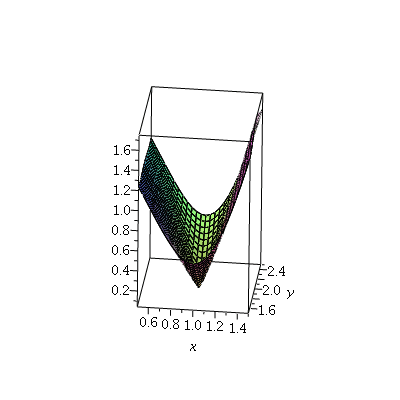 |
In fact, it is a theorem that if ![]() and its two first order partial derivatives
and its two first order partial derivatives ![]() and
and ![]() are continuous
are continuous
on some open set U in ![]() containing
containing ![]() then
then ![]() is differentiable at
is differentiable at ![]() That theorem applies
That theorem applies
in this example, since ![]()
![]() are all polynomial functions.
are all polynomial functions.
(Recall polynomials in x, y are continuous at all points in ![]() Next, we want to see what can "go wrong" if f is not differentiable at a point.
Next, we want to see what can "go wrong" if f is not differentiable at a point.
Example 2. Let ![]() if
if ![]() and = 0 if
and = 0 if ![]()
We will concentrate on the point ![]() Note that
Note that
![`and`(diff(f(0, 0), x) = `*`(D[1, 0], `*`(f(0, 0))), `and`(`*`(D[1, 0], `*`(f(0, 0))) = limit(`/`(`*`(`+`(f(h, 0), `-`(f(0, 0)))), `*`(h)), h = 0), `and`(limit(`/`(`*`(`+`(f(h, 0), `-`(f(0, 0)))), `*`...](images/Diff_112.gif) and
and
![]() So the "candidate" linear approximating function is
So the "candidate" linear approximating function is ![]() .
.
But the question is: does that linear function approximate the shape of ![]() well
well
near (0,0)?
| > |
 |
Next, the plot of ![]()
| > |  |
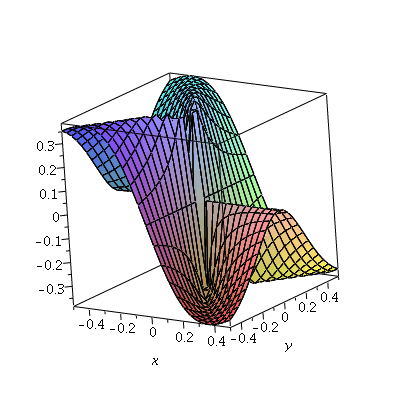 |
What should our conclusion be in this example? How can we make it rigorous?
| > |